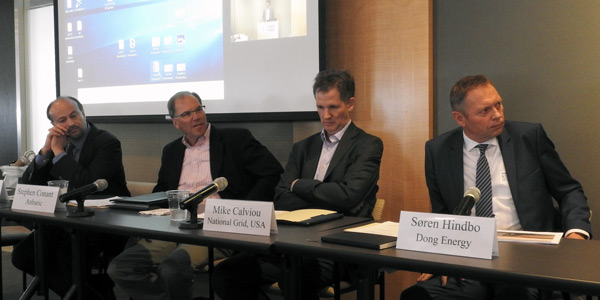By Michael Kuser
BOSTON — Massachusetts faces a big question in its plan to add 1,600 MW of offshore wind by 2027: What’s the best way to get the power to shore?
The state, which is expected to issue a request for proposals by the end of the month for at least 400 MW, will ask the three winners of offshore wind leases to propose both underwater transmission cables for each of their projects and a single trunk line that would serve all three. Developers also will have to choose between high-voltage AC or DC lines.

The stakes, as a panel told Raab Associates’ 154th New England Electricity Restructuring Roundtable on Friday, are high.

A multibillion-dollar offshore wind farm can be stranded for six months because of a single cable fault. However, developers can reduce their risk through contracts that provide compensation for transmission failures, said Søren Hindbo, senior director of electrical systems for DONG Energy. In addition, interlink cables among substations can allow electricity to be sent ashore even when an export cable fails, he said.
Denmark-based DONG — which has 26 years of offshore wind experience, with 21 European wind farms in operation and seven under construction — was one of three companies to win leases off of Massachusetts from the U.S. Bureau of Ocean Energy Management. Deepwater Wind and Vineyard Wind (formerly OffshoreMW) also won.

Hindbo described the contracts used in Germany, France, the Netherlands and Denmark, which provide wind developers compensation if there is a transmission problem. “You measure the wind speed on the wind farm and get compensated according to that, if for instance the connection is delayed or faulty. And that’s very important, because who wants to invest in something and have your billions put up there and no chance of getting anything back because you haven’t got an export connection?”

DONG expects two to three export cable faults per 100 km per 20 years, so having interlinks to provide alternative routes for delivering power is important, he said. “One benefit is you don’t need diesels [for] a black start; also if you are delayed, which often happens … you are still in the game,” Hindbo said.
In Europe, developers have found HVDC lines more cost effective for the most distant wind farms and AC better for those closer to shore, with a break-even point between 100 and 200 km (about 62 to 124 miles).

The export cable represents up to 60% of the total cost in an HVAC system. The total percentage is somewhat lower with a HVDC system, Hindbo said, though the total capital expenditure is higher. “The export cable,” he said. “It’s the weakest and the most expensive part.”
Backbone or Alternatives?

Mike Calviou, senior vice president at National Grid USA, said the most cost-effective approach is a “coordinated and expandable” plan that accommodates future offshore resources, citing research showing it can reduce costs by 8 to 16%. National Grid connected the first offshore wind farm in the U.S. to the grid, the 30-MW Block Island project off Rhode Island.
“We believe coordination does provide a range of benefits: fewer cables; you get the economies of scale; the permitting complexity can actually be significant. There are certainly, we believe, some environmental and safety benefits,” he said. “And particularly the expandability: When you know you are going to be doing more offshore wind … you can actually design for future expansion.”

Anbaric’s Stephen Conant said the RFP unwisely excludes transmission developers such as his company from participating in the design of a solution: They aren’t permitted to respond to the RFP except in partnership with one of the three wind developers/lease holders.
“We think competition is good for the industry,” Conant said. “Putting generators in the transmission business seemed a little odd in the RFP. We have a system here that we separate transmission and generation by having a common transmission system [onshore]. That then allows … those generators to bid competitively into the market.”
The RFP could give market power to the three leaseholders, he said.
“The way the construct is now, essentially if they pick one [bidder], then the first one in … their tendency is going to be to sort of lean towards the expansion of their [initial] 400 or 800 [MW]. So you’ve essentially gotten a little market power that exists as a result of not letting others into the field.”
Anbaric, which was among a group of entities that built the 660-MW Neptune HVDC cable linking PJM to Long Island Power Authority and the 660-MW Hudson project connecting PJM to New York City, is also developing the Vermont Green Line, a 400-MW project to deliver power from upstate New York into the New England grid.
Equal Treatment

Erich Stephens, CEO of Vineyard Wind, highlighted the risk of separating the transmission and generation projects. “If you separate as a matter of policy who builds the generation from who builds the cable, you basically have two projects going forward at the same time,” he said. “Inevitably those projects are not going to be finished at the same time … and that means you’re going to have a very expensive asset sitting offshore that’s not earning the revenue that it should.”
Vineyard Wind was already working with Copenhagen Infrastructure Partners on its offshore wind projects before earlier this year selling a 50% stake to Avangrid Renewables to bid in the Massachusetts RFP.


